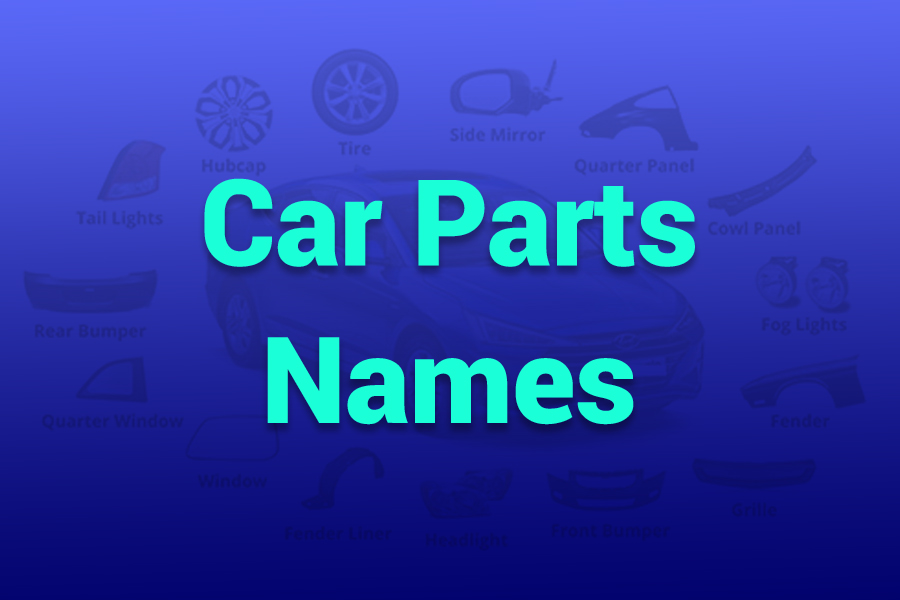
Every car is a complex system made up of thousands of interconnected parts. From the engine that powers your movement to the suspension that keeps your ride smooth, each component plays a vital role.
Understanding car parts names isn’t just for mechanics—it helps every driver make smarter maintenance decisions, communicate better with repair shops, and even buy parts with confidence. In this article, you’ll learn all the essential car parts names, their functions, and how they work together to keep your vehicle running safely and efficiently.
Understanding the Basics of Car Parts
Before diving into the specific names, it’s important to understand how car components are organized. A typical vehicle can be divided into several main systems: the engine, transmission, electrical, suspension, braking, steering, exhaust, and body structure. Each of these systems includes both large assemblies and smaller parts that perform specialized functions.
Modern vehicles often have between 25,000 and 30,000 individual components, according to recent estimates from automotive manufacturers. That includes everything from bolts and hoses to sophisticated sensors. While it may sound overwhelming, breaking it down by category makes it easy to learn.
- Engine Components
The engine is the heart of any car. It converts fuel into energy that powers your wheels. Here are the major parts of a car engine you should know:
- Cylinder Block: The foundation of the engine where combustion occurs.
- Pistons: Move up and down inside the cylinders to compress air and fuel.
- Crankshaft: Converts piston motion into rotational energy that drives the car.
- Camshaft: Controls the opening and closing of valves at the correct timing.
- Valves: Allow air and fuel to enter and exhaust gases to exit the combustion chamber.
- Spark Plugs: Ignite the air-fuel mixture to create combustion.
- Fuel Injectors: Deliver fuel into the combustion chamber with precise timing.
- Oil Pan: Holds the engine oil, which lubricates and cools moving parts.
Regular maintenance of these parts, such as oil changes and spark plug replacement, ensures smooth operation and prevents engine wear.
- Transmission System
The transmission transfers engine power to the wheels. It ensures your vehicle runs efficiently at various speeds. The main parts include:
- Clutch (in manual cars): Engages or disengages engine power to change gears.
- Torque Converter (in automatics): Performs a similar function using hydraulic fluid.
- Gearbox: Houses gears that control torque and speed ratios.
- Driveshaft: Delivers power from the transmission to the differential.
- Differential: Splits engine power between the wheels for smooth cornering.
Transmission systems are highly durable but require proper fluid levels to function correctly. Neglecting maintenance can lead to costly repairs.
- Steering and Suspension System
The steering and suspension system keeps your car stable and easy to control. Together, they determine how the vehicle responds to your input and handles road conditions.
Key components include:
- Steering Wheel: Your main control interface.
- Rack and Pinion: Converts the wheel’s rotation into side-to-side motion for the tires.
- Tie Rods: Connect the steering rack to the wheels.
- Shock Absorbers: Reduce the impact of bumps and potholes.
- Struts: Structural suspension parts that combine shocks and springs.
- Control Arms: Connect the wheels to the frame and allow for vertical movement.
- Ball Joints: Enable smooth pivoting between suspension parts.
Proper alignment and suspension health directly affect tire wear and ride comfort.
- Braking System
Stopping safely is as important as moving forward. Modern cars use advanced braking systems for consistent performance. Major components include:
- Brake Pedal: Initiates braking force.
- Master Cylinder: Converts pedal pressure into hydraulic force.
- Brake Lines: Carry brake fluid to each wheel.
- Brake Calipers: Press the brake pads against rotors to create friction.
- Brake Pads: Wearable parts that generate stopping power.
- Brake Rotors (or Discs): Spin with the wheels and provide surface area for pads to grip.
- ABS Sensors: Prevent wheel lock during hard braking.
Recent U.S. road safety data shows that nearly 22% of accidents involve faulty brakes, highlighting the importance of regular inspection.
- Electrical System
Cars have evolved into digital machines. Modern electrical systems manage everything from lighting to engine control. Important electrical parts include:
- Battery: Provides power to start the engine and run electronics when the engine is off.
- Alternator: Recharges the battery while the engine runs.
- Starter Motor: Turns the engine during ignition.
- Fuses and Relays: Protect circuits from overloading.
- ECU (Engine Control Unit): Acts as the car’s brain, managing performance and efficiency.
- Sensors: Monitor systems such as oxygen, temperature, and pressure.
- Wiring Harness: Distributes electricity throughout the vehicle.
Maintaining a healthy battery and electrical system ensures reliability and prevents starting issues.
- Cooling System
Engines generate a lot of heat. The cooling system prevents overheating and damage. Main components include:
- Radiator: Cools the engine coolant.
- Water Pump: Circulates coolant through the system.
- Thermostat: Regulates temperature by controlling coolant flow.
- Cooling Fans: Help maintain airflow through the radiator.
- Coolant Reservoir: Stores excess fluid for temperature expansion.
Neglecting the cooling system can lead to engine failure. Regular coolant checks are essential, especially in summer.
- Fuel System
Without fuel, nothing moves. The fuel system stores and delivers gasoline or diesel to the engine. Main parts include:
- Fuel Tank: Stores the fuel safely.
- Fuel Pump: Moves fuel from the tank to the engine.
- Fuel Filter: Removes impurities from the fuel.
- Fuel Lines: Carry fuel to injectors or carburetors.
Clean fuel systems improve efficiency and extend engine life.
- Exhaust System
This system channels harmful gases away from the engine and reduces pollution. Components include:
- Exhaust Manifold: Collects gases from cylinders.
- Catalytic Converter: Converts harmful gases into less toxic emissions.
- Muffler: Reduces engine noise.
- Tailpipe: Directs exhaust gases safely out of the car.
Environmental regulations in the U.S. require vehicles to maintain proper emission standards, making exhaust system care essential.
- Drive System
The drive system transfers power to the wheels. There are different configurations: front-wheel drive (FWD), rear-wheel drive (RWD), and all-wheel drive (AWD). Key parts are:
- Axles: Connect the wheels and deliver torque.
- CV Joints: Allow smooth motion between axles and wheels.
- Transfer Case (for AWD): Distributes power between front and rear axles.
Proper lubrication and inspection keep the drive system reliable.
- Body and Interior Parts
Beyond the mechanical elements, your car’s body and interior provide structure and comfort. Major body parts include:
- Chassis: The vehicle’s structural frame.
- Doors, Roof, and Fenders: Protect passengers and give the car its shape.
- Bumpers: Absorb impact during collisions.
- Windshield and Windows: Ensure visibility and protection.
- Mirrors: Improve awareness of surrounding traffic.
Interior components enhance comfort and control:
- Dashboard: Houses instruments and controls.
- Seats and Seatbelts: Provide comfort and safety.
- Air Conditioning and Heating: Regulate cabin temperature.
- Infotainment System: Offers connectivity, navigation, and entertainment.
A well-maintained interior improves driving experience and resale value.
- Lighting and Safety Systems
Lighting and safety components ensure visibility and protection. These include:
- Headlights: Illuminate the road ahead.
- Taillights: Alert drivers behind you.
- Brake Lights: Indicate when you’re slowing down.
- Turn Signals: Communicate direction changes.
- Airbags: Deploy during collisions to protect passengers.
- Seatbelt Pretensioners: Tighten belts instantly in crashes.
- Tire Pressure Monitoring System (TPMS): Alerts you of low tire pressure.
Recent safety data from the National Highway Traffic Safety Administration (NHTSA) shows that proper maintenance of these systems can reduce accident severity by up to 40%.
- Tires and Wheels
Tires are your vehicle’s only contact with the road. Their condition directly affects performance and safety.
- Tire Tread: Provides traction.
- Rims (Wheels): Hold the tires in place.
- Lug Nuts: Secure the wheel to the hub.
- Wheel Bearings: Allow smooth rotation.
Maintaining proper tire pressure, alignment, and balance ensures fuel efficiency and even wear.
- HVAC System (Heating, Ventilation, and Air Conditioning)
Comfort in all weather conditions depends on the HVAC system. Major parts include:
- Blower Motor: Pushes air through vents.
- Evaporator and Condenser: Manage temperature changes.
- Compressor: Circulates refrigerant.
- Cabin Filter: Cleans air entering the cabin.
Routine maintenance of this system keeps air fresh and reduces allergens inside the vehicle.
- Modern Additions in Today’s Cars
Technology has transformed modern vehicles. Cars now include:
- Advanced Driver Assistance Systems (ADAS): Features like lane departure warning and adaptive cruise control.
- Infotainment Displays: Touchscreen systems with smartphone integration.
- Electric Vehicle Batteries: Power source in EVs replacing traditional engines.
- Regenerative Braking Systems: Recover energy during braking.
The average U.S. car in 2025 now contains over 70 microprocessors managing these systems.
- Regular Maintenance and Why It Matters
Knowing car parts names is only the beginning. Regular maintenance ensures these components last longer and perform safely. Essential maintenance includes oil changes every 5,000–7,000 miles, tire rotations, brake checks, and fluid replacements. According to AAA, preventive maintenance can save drivers up to $1,200 annually in repair costs.
Drivers who understand their vehicle’s anatomy communicate more effectively with mechanics, recognize warning signs earlier, and make better purchasing decisions.
Conclusion
Every part of a car, no matter how small, contributes to performance, safety, and comfort. Understanding these car parts names helps drivers appreciate the engineering behind their vehicles and maintain them responsibly.
Whether you drive a classic sedan or a modern EV, this knowledge gives you control and confidence every time you hit the road.





